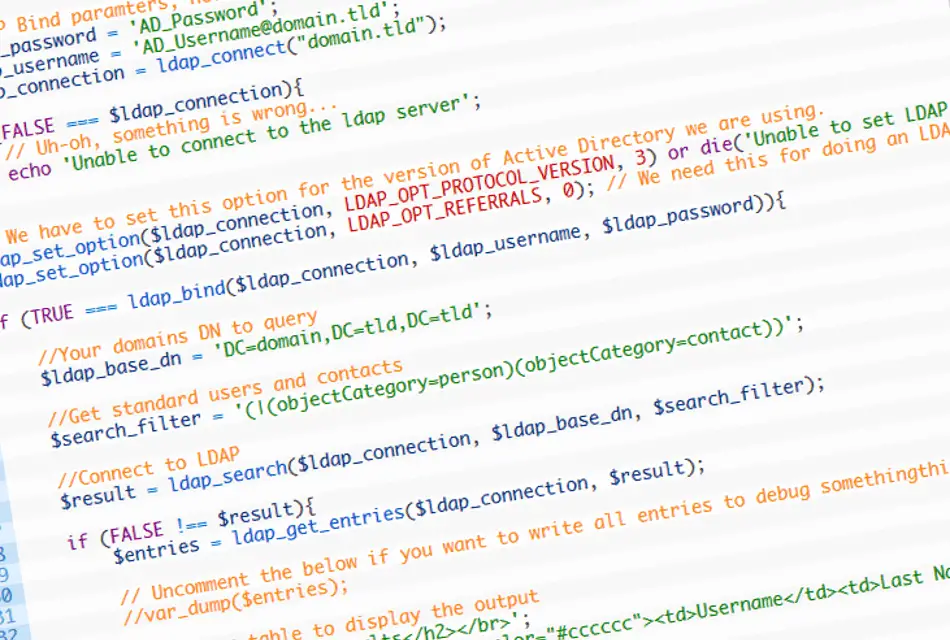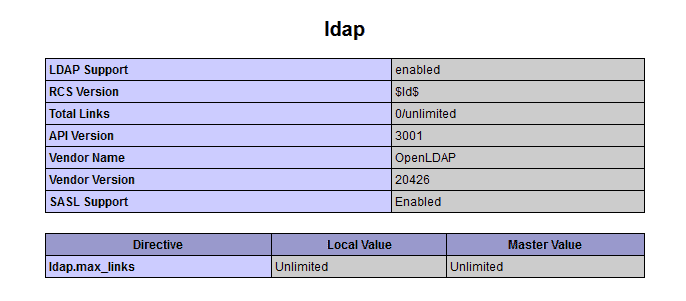Overview
The below PHP script is an example of how to connect to Active Directory via LDAP and retrieve a list of users’ details.
If instead, you are looking to retrieve information on computer accounts in the domain. Take a look at this post
Requirements
To use this script your PHP web server will need the LDAP module installed, you can verify the installation by creating a phpinfo file.
phpinfo.php
<?php
phpinfo();
?>
When browsing to this web page you should see an LDAP section;
If you don’t see an LDAP section in your phpinfo results you will need to install the php LDAP package, for example on Ubuntu / Debian;
# Install php5-ldap:
sudo apt-get install php5-ldap
# Reboot apache
/etc/init.d/apache2 restart
Variables to change
You will need to change the variables.
Line 4 - $ldap_password = 'AD_Password'; Line 5 - $ldap_username = '[email protected]'; Line 6 - $ldap_connection = ldap_connect("domain.tld"); Line 20 - $ldap_base_dn = 'DC=domain,DC=tld,DC=tld';
The Script
<?php
//LDAP Bind paramters, need to be a normal AD User account.
$ldap_password = 'AD_Password';
$ldap_username = '[email protected]';
$ldap_connection = ldap_connect("domain.tld");
if (FALSE === $ldap_connection) {
// Uh-oh, something is wrong...
echo 'Unable to connect to the ldap server';
}
// We have to set this option for the version of Active Directory we are using.
ldap_set_option($ldap_connection, LDAP_OPT_PROTOCOL_VERSION, 3) or die('Unable to set LDAP protocol version');
ldap_set_option($ldap_connection, LDAP_OPT_REFERRALS, 0); // We need this for doing an LDAP search.
if (TRUE === ldap_bind($ldap_connection, $ldap_username, $ldap_password)) {
//Your domains DN to query
$ldap_base_dn = 'DC=domain,DC=tld,DC=tld';
//Get standard users and contacts
$search_filter = '(|(objectCategory=person)(objectCategory=contact))';
//Connect to LDAP
$result = ldap_search($ldap_connection, $ldap_base_dn, $search_filter);
if (FALSE !== $result) {
$entries = ldap_get_entries($ldap_connection, $result);
// Uncomment the below if you want to write all entries to debug somethingthing
//var_dump($entries);
//Create a table to display the output
echo '<h2>AD User Results</h2></br>';
echo '<table border = "1"><tr bgcolor="#cccccc"><td>Username</td><td>Last Name</td><td>First Name</td><td>Company</td><td>Department</td><td>Office Phone</td><td>Fax</td><td>Mobile</td><td>DDI</td><td>E-Mail Address</td><td>Home Phone</td></tr>';
//For each account returned by the search
for ($x = 0; $x < $entries['count']; $x++) {
//
//Retrieve values from Active Directory
//
//Windows Usernaame
$LDAP_samaccountname = "";
if (!empty($entries[$x]['samaccountname'][0])) {
$LDAP_samaccountname = $entries[$x]['samaccountname'][0];
if ($LDAP_samaccountname == "NULL") {
$LDAP_samaccountname = "";
}
} else {
//#There is no samaccountname s0 assume this is an AD contact record so generate a unique username
$LDAP_uSNCreated = $entries[$x]['usncreated'][0];
$LDAP_samaccountname = "CONTACT_" . $LDAP_uSNCreated;
}
//Last Name
$LDAP_LastName = "";
if (!empty($entries[$x]['sn'][0])) {
$LDAP_LastName = $entries[$x]['sn'][0];
if ($LDAP_LastName == "NULL") {
$LDAP_LastName = "";
}
}
//First Name
$LDAP_FirstName = "";
if (!empty($entries[$x]['givenname'][0])) {
$LDAP_FirstName = $entries[$x]['givenname'][0];
if ($LDAP_FirstName == "NULL") {
$LDAP_FirstName = "";
}
}
//Company
$LDAP_CompanyName = "";
if (!empty($entries[$x]['company'][0])) {
$LDAP_CompanyName = $entries[$x]['company'][0];
if ($LDAP_CompanyName == "NULL") {
$LDAP_CompanyName = "";
}
}
//Department
$LDAP_Department = "";
if (!empty($entries[$x]['department'][0])) {
$LDAP_Department = $entries[$x]['department'][0];
if ($LDAP_Department == "NULL") {
$LDAP_Department = "";
}
}
//Job Title
$LDAP_JobTitle = "";
if (!empty($entries[$x]['title'][0])) {
$LDAP_JobTitle = $entries[$x]['title'][0];
if ($LDAP_JobTitle == "NULL") {
$LDAP_JobTitle = "";
}
}
//IPPhone
$LDAP_OfficePhone = "";
if (!empty($entries[$x]['ipphone'][0])) {
$LDAP_OfficePhone = $entries[$x]['ipphone'][0];
if ($LDAP_OfficePhone == "NULL") {
$LDAP_OfficePhone = "";
}
}
//FAX Number
$LDAP_OfficeFax = "";
if (!empty($entries[$x]['facsimiletelephonenumber'][0])) {
$LDAP_OfficeFax = $entries[$x]['facsimiletelephonenumber'][0];
if ($LDAP_OfficeFax == "NULL") {
$LDAP_OfficeFax = "";
}
}
//Mobile Number
$LDAP_CellPhone = "";
if (!empty($entries[$x]['mobile'][0])) {
$LDAP_CellPhone = $entries[$x]['mobile'][0];
if ($LDAP_CellPhone == "NULL") {
$LDAP_CellPhone = "";
}
}
//Telephone Number
$LDAP_DDI = "";
if (!empty($entries[$x]['telephonenumber'][0])) {
$LDAP_DDI = $entries[$x]['telephonenumber'][0];
if ($LDAP_DDI == "NULL") {
$LDAP_DDI = "";
}
}
//Email address
$LDAP_InternetAddress = "";
if (!empty($entries[$x]['mail'][0])) {
$LDAP_InternetAddress = $entries[$x]['mail'][0];
if ($LDAP_InternetAddress == "NULL") {
$LDAP_InternetAddress = "";
}
}
//Home phone
$LDAP_HomePhone = "";
if (!empty($entries[$x]['homephone'][0])) {
$LDAP_HomePhone = $entries[$x]['homephone'][0];
if ($LDAP_HomePhone == "NULL") {
$LDAP_HomePhone = "";
}
}
echo "<tr><td><strong>" . $LDAP_samaccountname . "</strong></td><td>" . $LDAP_LastName . "</td><td>" . $LDAP_FirstName . "</td><td>" . $LDAP_CompanyName . "</td><td>" . $LDAP_Department . "</td><td>" . $LDAP_OfficePhone . "</td><td>" . $LDAP_OfficeFax . "</td><td>" . $LDAP_CellPhone . "</td><td>" . $LDAP_DDI . "</td><td>" . $LDAP_InternetAddress . "</td><td>" . $LDAP_HomePhone . "</td></tr>";
} //END for loop
} //END FALSE !== $result
ldap_unbind($ldap_connection); // Clean up after ourselves.
echo ("</table>"); //close the table
} //END ldap_bind


Thank you it works I have tried it and its so successful ,GOD bless you
Quick and easy, thanks a lot
Thanks for the code , But i am unable to import large user . Eg 10 k users
Hi,
I don’t have a data set that large to test with, but I would imagine you will need a couple more ldap_set_option‘s at the top.
LDAP_OPT_SIZELIMIT (integer)
Specifies the maximum number of entries that can be returned on a search operation.
Note: The actual size limit for operations is also bounded by the server’s configured maximum number of return entries. The lesser of these two settings is the actual size limit.
LDAP_OPT_TIMELIMIT (integer)
Specifies the number of seconds to wait for search results.
Note: The actual time limit for operations is also bounded by the server’s configured maximum time. The lesser of these two settings is the actual time limit.
Good morning!!
How can i sort the result by smaccountname for example?
I don’t know how to create this cod.
Thank you.
One way would be to use the ldap_sort after the ldap_search on line 26 for example
ldap_sort($ldap_connection, $result, ‘samaccountname’);
However this is not the best way as ldap_sort has been depreciated in php 7
http://php.net/manual/en/function.ldap-sort.php
This does not work “ldap_sort($ldap_connection, $result, ‘samaccountname’);”,
Im PHP noob, can you help little bit more?
Cant get it work, can you help me little bit more? I need to sort it by samaccountname, that ldap_sort looks like good, but it just end with page cannot be displayed.
Hey I also tested it out and it worked fine but when I am trying to get the path of an image, which has the Attribue labeledURI.
I replaced the Attribute from ‘homephone’ (line 163 &164) to ‘labeledURI’ but I get a reply that it is empty.
I used sysinternals to this this but the programm shows me the path of the profile image.
Any ideas?
For anyone who maybe has the same problem: you have to write the Attribute in lowercase so if I use ‘labeleduri’ it will work.
Great find, thanks for letting us know!
how to fetch particular department from AD
Is it possible to retrieve pc names associated with the user?
Thanks
Mike
Hi
This is really good but what I need is to populate the dropdown with the users from the AD of specific OU like ITS Department
Hi,
You would need to change the base dn to filter based on the OU you are interested in. Stick the the result into a variable for use in your drop down list.
$ldap_base_dn = ‘OU=ITDept,DC=domain,DC=tld,DC=tld’;
Thanks
Phil
Thanks a lot very simple and easy and very clear . thanks again
Hi, great code. How can I get the computer names as well?
Thanks
Hi,
Take a look at this post I just put up A PHP Example of how to get computer account data from Active Directory via LDAP
I hope this helps?
Thanks
Phil
Thanks for the quick reply!
This is the first time that I am authenticating with LDAP and I am lost with the values that are in the variable $ldap_base_dn.
What to put in DC = domain? what is DC = tld?
My search is returned empty.
Hi Bruno,
So you will need a user account in your Active Directory domain, just a standard user no admin rights is required.
You will also need to know your domain name. The are many ways to get this, but f your computer is joined to the domain your are looking to query you could run the following in a command prompt.
systeminfo | findstr /B /C:”Domain”
So for example lets assume I know these values;
AD Username = Bruno
AD Password = Bruno1234$
AD Domain = Bruno.com
The scripts variables would look like this
Line 4 – $ldap_password = ‘Bruno1234$’;
Line 5 – $ldap_username = ‘[email protected]’;
Line 6 – $ldap_connection = ldap_connect(“Bruno.com”);
Line 20 – $ldap_base_dn = ‘DC=Bruno,DC=com’;
If you domain has two bits at the end like Bruno.co.uk line 20 would instead look like this
Line 20 – $ldap_base_dn = ‘DC=Bruno,DC=co,DC=uk’;
DC stands from domain component in the world of LDAP
TLD is top level domain. .com, .co.uk….
I hope that helps?
Thanks
Phil
I understand now, in my case my domain name is (rectvi.record.local) and in the variable $ ldap_base_dn = ‘DC = rectvi, DC = record, DC = local’;
However, even with the changes it presents the following error: Warning: ldap_search (): Search: No such object in …
Hello again, the question above has been resolved. In this case, the variable is like this $ ldap_base_dn = ‘DC = record, DC = local’;
Thank you for your attention
Happy to help, I am glad you got it resolved !
Thanks
Phil
Hi Phill, can you help me to search data only same user, for example: how can i get Fist Name, Second Name, Email, Departament and more entries of only one user.
Hi,
You could modify the search filter (line 23) to search based on the users username (sAMAccountName)
(&(objectCategory=person)(objectClass=user)(sAMAccountName=BRUNO)
How to write LDAP search filters
https://confluence.atlassian.com/kb/how-to-write-ldap-search-filters-792496933.html
Common LDAP Properties and Script Attributes List with Examples
https://www.computerperformance.co.uk/logon/ldap-attributes-active-directory/
Phil
Thanks again Phil, God bless you.
It worked the way I wanted
Is there an easy way to pull thumbnailphoto ?
I got Photos! but im sure theres a better way to do it
//Home phone
$LDAP_HomePhone = “”;
if (!empty($entries[$x][‘thumbnailphoto’][0])) {
$LDAP_HomePhone = $entries[$x][‘thumbnailphoto’][0];
if (isset($entries[0][“thumbnailphoto”]) && isset($entries[0][“thumbnailphoto”][0])) {
if ($LDAP_HomePhone == “NULL”) {
$LDAP_HomePhone = “”;
Then in the echo i have
“” . ” . “”;
I had no use for homephone so i changed that around instead of another entry
Thank you! this information resolve my issue. Please read more about the Active directory